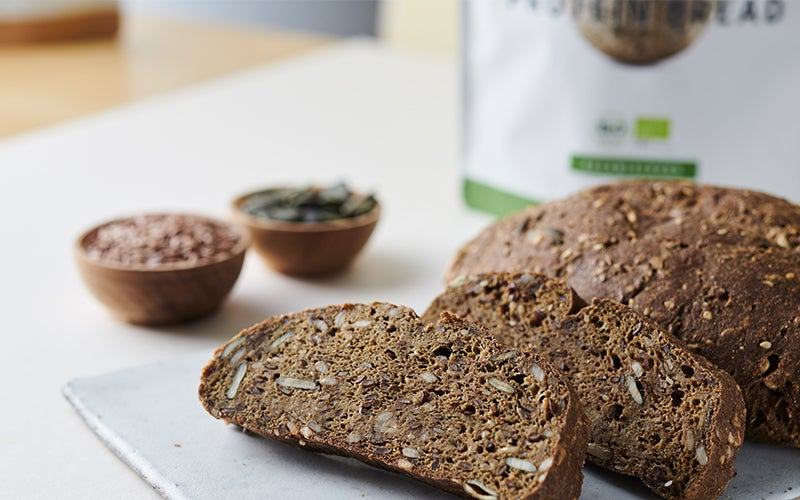A Quick Guide to the Low FODMAP Diet
 ©PeopleImages
©PeopleImages
First things first: The low FODMAP diet is a medical treatment for digestive problems – not a trendy fad diet. If you want to try this diet, you must consult a doctor before starting. But you might be wondering: What are FODMAPs anyway and how does a low FODMAP diet work? Would a switch help you?
What is a Low FODMAP Diet?
The low FODMAP diet gives dietary recommendations for people with digestive problems and (suspected) irritable bowel syndrome. A diet low in FODMAPs is designed to alleviate symptoms without requiring a much more restricted diet or permanently avoiding certain types of food.
All food groups contain foods high and low in FODMAPs. In some people, a high FODMAP content causes symptoms such as abdominal pain, gas, diarrhea, and bloating. Depending on your individual sensitivity or GI disorders, it can be good for your physical health and comfort to avoid FODMAPs.
Proponents of the FODMAP diet say it’s best for people with IBS to avoid certain foods as a matter of principle. At the same time, it is important to remember that digestive problems are not always due to FODMAPs and FODMAPs are not fundamentally bad. That’s why our free recipe database has irresistibly delicious ideas for every style of eating we can help with.
Before you go on a low FODMAP diet and ban certain foods from your life for the sake of improving your health, always talk to a doctor or qualified dietitian about your problems. IBS, in particular, can have many root causes and should always be examined holistically in the context of all your health information.
What Does FODMAP Stand For?
The abbreviation FODMAP stands for fermentable, oligosaccharides, disaccharides, monosaccharides and polyols. So FODMAPs are essentially fermentable sugars and a type of carbohydrates. Which means it’s time for a brief refresher on carbs!
- Monosaccharides are simple sugars consisting of one sugar molecule, like glucose and fructose. High fructose corn syrup is made up of monosaccharides.
- Disaccharides are double sugars consisting of two sugar molecules, including lactose and granulated sugar.
- Oligosaccharides consist of at least three monosaccharides linked together. They are particularly common in fermented foods.
- Polyols are sugar alcohols, but chemically they are neither alcohol nor sugar. They are used as sugar substitutes and include xylitol and erythritol.
FODMAPs occur naturally in some foods. Low FODMAP foods naturally contain fewer FODMAPs than others; they haven’t been processed to be part of a low FODMAP diet.
A low FODMAP diet is not inherently good for your health, nor does it automatically prevent IBS. Instead, the low FODMAP diet is designed to improve specific digestive symptoms, so you shouldn’t just eliminate fructose and other carbs on the off chance they’re a problem, but always seek professional medical advice from dietitians first.
What do FODMAPs do?
FODMAPs aren’t bad for your health per se, they’re just difficult to digest. Their properties make them difficult or impossible for the small intestine to absorb. Some molecules are not digestible because of their size, for others enough enzymes aren’t available for further processing.
If the FODMAPs from your diet make it into the large intestine, they are fermented by the intestinal bacteria and form gases there which can result in issues like flatulence. In addition, FODMAPs bind water and can therefore cause diarrhea.
Monosaccharides, fructans, galactans etc. aren’t metabolized in the exact same way, but they can cause the same kind of digestive symptoms. For someone without any gut disorders, they’re normally not a problem at all.
What Should I Avoid?
With the low FODMAP diet, you design your diet so that you eat as few fermentable carbohydrates as possible. The best way to do that is to make a list of foods with few FODMAPs that you particularly enjoy.
FODMAPs are a natural component of many foods. They are often found in large quantities in stone fruit and dairy products but they can’t be traced to just a few specific food groups.
At first glance this may seem complicated, but it also has a definite advantage: with good planning, your FODMAP diet can remain pretty varied, although you will have to cut back on some high FODMAP foods.
Nevertheless, nutrient deficiencies can occur during a very strict low FODMAP diet: both because avoiding FODMAPs restricts your food choices, and because diseases of the intestine, like IBS, have a negative impact on the absorption of nutrients.
The lists below give you a brief overview of which foods contain more or less FODMAPs, but they aren’t comprehensive.
Low FODMAP Foods: Fruits & Vegetables
- Bananas
- Bell peppers
- Blueberries
- Broccoli
- Brussels sprouts
- Carrots
- Chickpeas
- Cucumber
- Eggplant
- Fennel
- Grapes
- Kohlrabi
- Lemons
- Mung beans
- Parsnips
- Pineapple
- Potatoes
- Pumpkins
- Raspberries
- Spinach
- Strawberries
- Tomatoes
Low FODMAP Foods: Sources of Protein
- Eggs
- Fish
- Lactose-free milk
- Mozzarella
- Tempeh
- Tofu
Low FODMAP Foods: Grains
- Buckwheat
- Corn
- Gluten-free products like pasta and bread
- Oats
- Spelt
- Rice
Does low FODMAP bread exist?
At the beginning of your low FODMAP diet, or when treating classic IBS, it can be helpful to avoid bread for a while, until you and your doctor or nutritionist have found out which grains you tolerate.
Then try to bake bread with a recipe that doesn’t cause you any discomfort. Classic wheat flour breads and other flours containing gluten usually don’t fit into the FODMAP diet due to their high FODMAP content.
Beware of confusion: Ready-made bread often contains many different additives – it’s possible that people with IBS symptoms can trace them back to something other than FODMAPs.
Tip: Try our gluten-free Protein Bread, made with pumpkin seed protein, flaxseed, and other top-quality ingredients. Super delicious and prepared in just 30 minutes. No special equipment required!

High FODMAP Foods: Fruits & Vegetables
- Apples
- Artichokes
- Asparagus
- Beans
- Beets
- Blackberries
- Cherries
- Chicory
- Currants
- Dates
- Leeks
- Mushrooms
- Nectarines
- Olives
- Onions
- Peas
- Pears
- Plums
- Purple cabbage
- Pointed white cabbage
- Savoy cabbage
High FODMAP Foods: Sources of Protein
- Buttermilk
- Cream cheese
- Milk
- Yogurt
High FODMAP Foods: Grains
- Barley
- Bulgur
- Couscous
- Green spelt
- Muesli or granola
- Rye
- Semolina
- Wheat
How Does It Work?
What the low FODMAP diet looks like for you depends on your symptoms. In general, low FODMAP diets usually run in three phases.
- Week 1–8: Eliminate FODMAPs
During this phase of the diet, you try to eat no FODMAPs, or as few as possible. Dietitians often recommend avoiding fructose altogether – so no products with high fructose corn syrup! This strict phase is when the risk of malnutrition is at its highest. - Week 9 – XX: Test phase
Now’s the time you start testing individual foods by gradually introducing FODMAPs again. For example, you might eat a small selection of foods containing FODMAPs for 3-4 days and keep a precise record of your digestive symptoms: How does your gut health feel? Do you have gas or bloating? Your intestines will thank you if you really follow the diet during this phase and carefully document all your IBS symptoms. Only then can you find out which trigger foods are really causing your IBS symptoms and be sure of what’s leading to symptom relief. - Transition to a long-term diet
Based on the findings from the second phase, your dietitian will discuss your treatment with you and together you’ll create a diet that will work for you in the long term.
3 Tips To Make It Through The First 2 Phases of the Low FODMAP Diet
#1 Plan your shopping
This will help you during the first few weeks of your diet especially, when you aren’t sure yet which foods contain monosaccharides and polyols and so on. A shopping list helps you buy the right foods. It’s also a good idea to write down an alternative you can buy when your preferred food is unavailable.
#2 Invite friends over
Eating out is hard during a strict low FODMAP diet. So invite your friends over and cook for them yourself! Use new or rare foods from your diet to inspire you to create new meals.
#3 Choose friendly places to eat
If you do have to eat out, choose a restaurant that offers the right options for your symptoms. Chinese or Thai restaurants often have rice or rice noodles with vegetables on the menu as standard. Some Italian restaurants also have gluten-free pizza dough made with buckwheat.
Make yourself a list of high FODMAP no-go vegetables and legumes and ask for substitutions if you need to. If possible, bring your own sauce or choose the sauce that sounds like it has the fewest FODMAPs. Have it served separately and only eat as much of it as you really need.
If you suffer from serious gut symptoms, diagnosed irritable bowel syndrome, or other disorders, coordinate your low FODMAP diet and possible exceptions with your doctor.
Conclusion
- FODMAP stands for fermentable, oligosaccharides, disaccharides, monosaccharides and polyols.
- The low FODMAP diet is used for the treatment of irritable bowel syndrome and other digestive problems.
- Irritable bowel syndrome is a serious condition. If you have symptoms that suggest IBS, always consult your doctor instead of trying the low FODMAP diet on your own.
More healthy living tips from foodspring:
- The Secret Reason You Should Eat Peanut Butter Before Bed
- Easy Running Plans to Ensure you Crush your First 30 Minutes, 5K, or 10K
- Here’s What Alcohol Does to Your Muscle Growth Goals
Sources for this article
We at foodspring use only high-quality sources, including peer-reviewed studies, to support the facts within our articles. Read our editorial policy to learn more about how we fact-check and keep our content accurate, reliable, and trustworthy.
- Gibson PR. History of the low FODMAP diet. J Gastroenterol Hepatol. 2017 Mar;32 Suppl 1:5-7. doi: 10.1111/jgh.13685. PMID: 28244673.
- Roberfroid MB. Health benefits of non-digestible oligosaccharides. Adv Exp Med Biol. 1997;427:211-9. doi: 10.1007/978-1-4615-5967-2_22. PMID: 9361846.
































